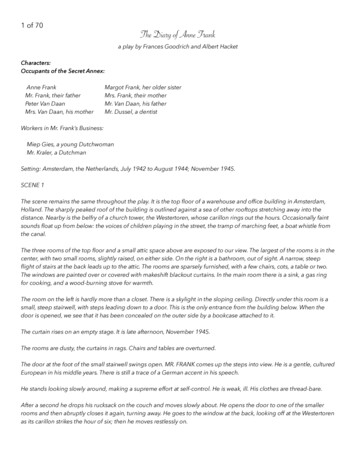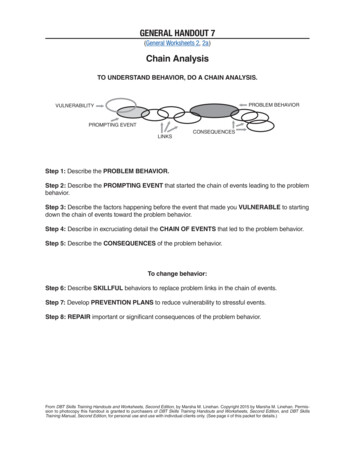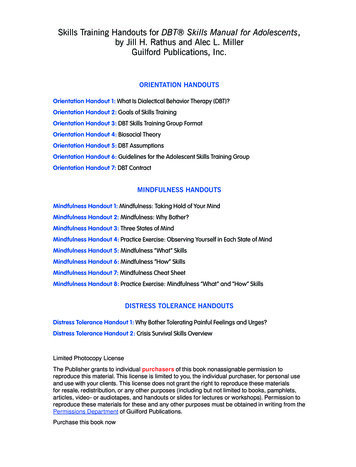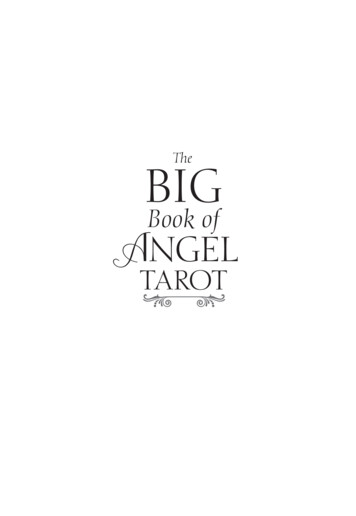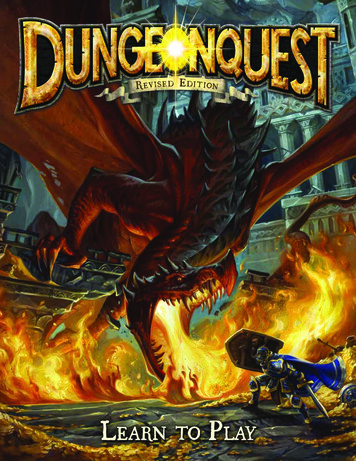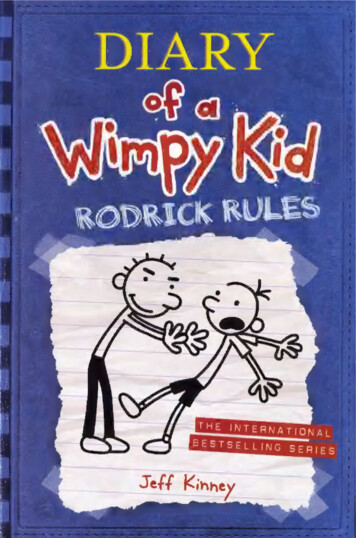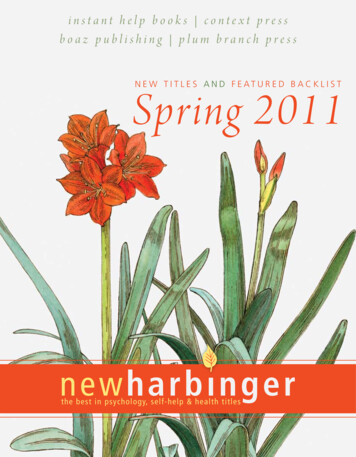
Transcription
(Handouts & Worksheets)Page Dan and Tasha Tonning 2018 Peer Guided DBT Lessons1DBT DIARY CARDS
DBT DIARY CARDS / WHYAccurate Memory RecordsDialectical Behavior Therapy (DBT) Diary Cards are in a table (grid-like) format which assists intracking when a target symptom occurs, along with the skill used to cope with it. They providea record of both the frequency of and the intensity of behaviors that are problematic. Accurateinformation about these behaviors is needed to be able to change them. This provides us withclear signals of target behaviors that should be assessed.Mood and emotions can have a powerful effect on a person’s memory. How we feel affectshow we store and organize elements retained in memory. Our emotions also determine whichmemories are retrieved and even how we process things we remember. It is easier toremember information put into storage in while we were feeling emotions that match ourcurrent emotion. Our natural ups and downs in mood and emotions can result in usremembering mostly the positive or negative aspects of a situation. Because of our fluctuationin mood can interfere with our ability to accurately assess a situation, reliance on our memoryalone can make it difficult to obtain accurate information.Discovering Interwoven LinksThe cognitive behavioral principles of DBT state that thoughts, feelings, and behavior areintricately linked influencing each other. Changing a thought can change how we feel and behave.Changing an emotion can change how we think about a situation and how werespond.Changing a behavior can change how we feel and how we think.Deliberately practiced effective (positive) behavior contributes to improvement of ourthoughts and feelings.Filling out a diary card requires self-monitoring in all three of these areas: thoughts, emotions,and behaviors. This self-awareness is widely recognized as the first step to self-improvement.For those in therapy, the completed diary card can enable the therapist to aid the client inexploring possible links between situations, thoughts, emotions, and behavior. They providean organized over-view of the week and can serve to give a therapist a basis for futurediscussion and where further work is needed.Diary cards can be tailored to address the specific targets personal to each individual.Whenever life threatening behaviors exist, these should be the first monitored behaviorsrecorded.Page Dan and Tasha Tonning 2018 Peer Guided DBT Lessons2Behaviors that interfere with quality of life should then be prioritized according to the level ofdisruption they cause.
Daily RemindersSince the card asks you to evaluate each DBT Skill on how it was used (or not) you arerequired to read through a list of all DBT skills. Since these skills are listed by module you willbe reminded of the objective of each. Reading these daily can help to keep them fresh in yourmemory, thus increasing the likelihood that the skill needed to cope with a specific situationwill come to mind when it is needed.There are so many different DBT skills with each intended for different types of targetbehaviors, anything that can help us to remember which would be most effective in any givencircumstance is beneficial. Keeping with you a list of skills or other tangible reminders can behelpful, but the most effective reminder is to learn them.Reading your Diary card at least once daily (in order to fill it out) is definitely productive tolearning them.Charting ChangeDiary Cards function as a record that someone can review to not only remember how theycoped with past experiences but also to identify areas of progress and where more work isneeded.When you start filling in your cards you may be surprised at how many of these skills you havepracticed throughout any given day. Many of these have been learned and incorporated intoour life skills without officially learning them within the context of DBT. No matter if the skillcame to you naturally or you had to deliberately practice it, you need to record it as anaccomplishment every day that you successfully use that specific skill. Validating your skillfuluse of the skills helps to reinforce areas in which you have been skillful. Being able to clearlysee where skills have improved the situation will make it easier to put them into use in similarfuture circumstances.When you learn a new DBT skill it is like any other skill you learn, in one respect. You can notlearn to use it without practice. The more you practice - the more skillful and masterful youwill become. Being able to see not only the frequency of the skill increase but also theeffectiveness proficiency increasing over time, along with the positive effect this has had onyour life - you will become more motivated to continue working hard to learn them all.Page Dan and Tasha Tonning 2018 Peer Guided DBT Lessons3If you see areas in your card that no improvement is recorded, this can alert you to the areasthat need more work before growth will occur. You might see that you are trying to use that/ those skills to help with the wrong types of situations, causing them to be ineffective. Youmight see that you are not putting focus on the practice of that skill. Whatever the reason youdiscover, you receive the message that something you are doing (or not doing) needs to bechanged.
DBT DIARY CARDS / HOWDBT is typically taught in rounds. New members are added at the beginning of each new module.When someone begins any one of the four modules, it could be their first module. The system ofrounds is most effective to reach as many people as possible because as someone completes a round,they may leave, which leaves room for another to step right into that slot. Others unfortunately willalso drop out leaving an empty slot. This means that members will have completed different modulesthan others within the group.This system can cause different member’s diary cards to be completed to differing degrees. While oneperson is just beginning DBT and learning their first skills, others may be working on their final moduleand be able to almost completely fill in their diary cards. It is important to remember to onlyconcentrate on the skills you have learned.Another unique factor in DBT is that many of us have vastly different target behaviors that we need toaddress. The first, most important targets would be any behaviors that could cause harm to self orothers, with the severity of that harm risk being taken into consideration. If a person suffers withsuicidal ideation, they would list that as their first target behavior. Someone may have targets theywish to deal with, but severity of risk should always be the first factor considered in choosing targets.Some people may not have any suicidal thoughts or active deliberate self-harm behaviors. For someperhaps their highest risk factor is drug, alcohol abuse, or other addiction. For those self-harm thoughtsor actions would not be considered as a target for them, their first target would be the substance abuse.Some people may not need to consider either of these issues because they simply aren’t a problembehavior in their case. Perhaps for some their highest risk would be something that simply interfereswith them feeling that they are living a life worth living.Some of the Conditions that DBT has been found to effectively treat or improve symptoms in; and apossible target behavior in each that might interfere with their quality of life:Conditions that benefit from DBTPossible Target BehaviorsAnxiety disordersObsessive compulsive disorder (OCD)Post-traumatic stress disorder (PTSD)Social phobiaBipolar disorderSchizophreniaDepressionPersonality disordersEating disordersAttention deficiency hyperactivity disorder (ADHD)AutismSubstance abuse i.e. drug or alcohol abuseChronic pain, such as that caused by an existingdisease or ongoing treatment for another conditionEmotional distressFear of something known to be harmlessNeed for something to be exactly “so”Not being present in the momentWithdrawing from societyReacting to the cyclesAccepting beliefs / feelings as factsInactivity / No positive accumulations(Any of the behaviors listed)Binge EatingMulti-taskingBland EmotionsDrinking or UsingUncontrolled Pain4 Dan and Tasha Tonning 2018 Peer Guided DBT LessonsPageMANY MANY MOREAn inability to manage any emotionOverwhelming emotionsANYTHING INTERFERING WITH LIFE
STEPS IN FILLING OUT CARDEXAMPLE DIARY CARDSTEP 1. The first thing you will do when filling out your diary card is to enter the DATES thiscard will cover. In our card we have the week begin on Sunday and end on Saturday. If youstart yours on a different week day, just adjust your dates on this section.STEP 2. Next you fill in the most troubling TARGET BEHAVIOR you would like to improve,plus up to two others you would like to change.Working on too many things at one time can become overwhelming. It is best to start with nomore than three. You will change your list as you feel you are fully able to manage one ofthese behaviors, by replacing that one with another target.Below is an example list of POSSIBLE TARGET behaviors.STEP 3. Evaluate the intensity of each EMOTION you felt on each day, entering the matchingnumber in that emotion’s column for that day.Shame:This is one possible option for the emotion evaluation of shame on Sunday: 5 for Extreme. Dan and Tasha Tonning 2018 Peer Guided DBT LessonsPageIt is not unlikely for someone experiencing shame of that intensity – that intense emotionalpain would accompany that shame: 5 for Extreme.5Emotional Pain:
Envy:It is consistent that if someone is feeling extreme emotional pain, they might be envious of others whoare happy and peaceful. For this example, we will evaluate this emotion as a: 2 for only somewhat.Sad:Sadness is so closely related to emotional pain, so it would be expected for that to be rather intense ifthe pain is extreme. For this evaluation we will rate this one as a: 4 for Very Strong.Fear:It would not be unusual for a person feeling intense emotional pain to have very little fear, since thatkind of pain could cause more of an “I don’t care what happens” feeling. For our example we will ratethis one lower: 1 for A little bit.Guilt:Even if the person believes they have nothing to be guilty for, they may still be feeling guilty. For thisone lets give it a rating: 3 for Somewhat.Jealous and Joy:On the evaluation for emotions felt for the day, one could conclude that neither of these may havebeen felt. We will rate both of these: 0 for Not at all.Page6 Dan and Tasha Tonning 2018 Peer Guided DBT Lessons
STEP 4 Mark with a check the emotion you felt the strongest on that day.STEP 5 Record any urges to participate in any of your target behaviors(That You Listed on Step 2) that day along with rating the intensity of that urge if it was felt.For out example card we will estimate that we had an urge to commit suicide on that day with theurge intensity rated: 3 for Rather StrongSTEP 6 Record if you followed your recorded urge through with any action.We will conclude that the urge to commit suicide existed, the person in our example did not act on it.REPEAT STEPS 5-6 with the other two Target Behaviors. Dan and Tasha Tonning 2018 Peer Guided DBT LessonsPageDue to isolating there would be nobody around to trigger the desire to lash out: 0 for Not at all, andNo for action.7It would be a normal reaction for a person with intense emotional pain to want to avoid others. In thisexample answer we will rate the urge: 4 for Very Strong This urge would be easy to follow throughwith, so we will say this person could answer: Yes
Second Page: Add Dates above ChartSTEP 8: Record Skill Effectiveness on all sections possible. Due to the lesson plan’s review /overview of the Mindfulness module between all modules, you should have a basicknowledge of these skills even if proficiency in use is not to expected.On all other modules you have not completed it is most likely that you will not be able togive any answer. Only fill in entries you are able to.When you start with a new module, you will only be able to fill in the lessons as you learnthem. There will be mostly blanks in the first weeks.A couple of the skills are broken down into the individual tools within that skill. When youcome to “Other” enter the tool you used.Page8 Dan and Tasha Tonning 2018 Peer Guided DBT Lessons
Dan and Tasha Tonning 2018 Peer Guided DBT LessonsPageAs you see, the more DBT you learn, and practice; the higher your skillfulness will be rated. Youcan actually visualize your growth in skillfulness.9Use of the skills will be recorded daily within a number range from 0-7 that best describesyour usage of this skill. Only fill in answers on skills that you have learned.
Third Page: Add Dates above ChartCOGNITIVE DISTORTIONSBlack and White Thinking Seeing things in terms of extremes.Inability or unwillingness tosee shades of gray distorts the facts.Filtering A mental filter that focuses only on a single negative while excluding all the positivecan foster a negative view of the facts.Overgeneralizing Taking one instance or example and viewing everything by that standard.Assigning patterns based on too few instances for a generalization to be applied can overshadow thefacts with negative thoughts.Mind-Reading Inaccurately believing that we know what another person is thinking. Jumpingto that conclusion can distort the facts with negative interpretations.Fortune Telling Coming to conclusions and making predictions on little or no evidence. Thistendency to hold these beliefs as facts can cause the facts to be distorted negatively.Emotional Reasoning Concluding that an emotional reaction to something defines its reality.Believing that your feelings prove how things really are distorts the facts.Personalization Claiming responsibility for external negative events, even when you were notresponsible. This negatively distorts the facts of cause and effect.Should Statements Setting expectations that are not likely to be met. This distorts facts byadding judgements and pressure.Disqualifying the Positive Acknowledging positive experiences but rejecting those ratherthan embracing them. Distorts the facts by removing any bright experiences.Catastrophizing Magnifying something unpleasant into something worse than reality.Expecting disaster to strike.Labeling Labeling ourselves or others based on situation specific behavior.STEP 7 Record Positives Accumulated each day.Participating in positive (pleasant) events increases a person’s pleasant emotions. A store of positiveexperiences helps us to keep our balance when the negative experiences in life occur. The lesspositive(s) we store up, the further down our emotions will sink when we face the negatives that are apart of everyday living. In order to build a life worth living a person must accumulate positives. Whenpositive experiences occur naturally, be mindful of them. Take special note that they occurred. If theydo not, deliberately do something to add to your accumulation. This is not something that can be doneonly when you feel like it, if you don’t feel like it, use opposite action.Think of Accumulating Positives in terms of adding pennies to a piggy bank. The more you save, themore you have available to help cover a drop in your emotional state created by a Negative. Dan and Tasha Tonning 2018 Peer Guided DBT LessonsPageNo day in this portion should ever be left blank. You should strive to have at least one positive to addto this list every day. This doesn’t need to be anything big. If for some reason you can not participatein any positive, please use this line to explain why.10EXAMPLE:
DIARY CARDS BIBLIOGRAPYEmotion Affects Memory's Reliability. (2010, June 28). Retrieved February 23, 2019, fromhttps://www.nsf.gov/news/news summ.jsp?cntn id 117140News Release 10-110Kim, J. S., Vossel, G., & Gamer, M. (2013, October 7). Effects of Emotional Context on Memory forDetails: The Role of Attention. Retrieved February 23, 2019, fromhttps://journals.plos.org/plosone/article?id 10.1371/journal.pone.0077405Matta, C. (2010, September 27). Diary Cards: How Keeping a Record Can Help You Change. RetrievedFebruary 23, 2019, from rson, F., DR. PhD. (n.d.). The role of emotion in memory. Retrieved February 23, 2019, , J., Psy.D. (2016, November 23). How to Use DBT Diary Cards. Retrieved February 23, 2019, fromhttps://openforest.net/use-dbt-diary-cards/The Diary card: Good, bad and even ugly. (2011, February 18). Retrieved February 23, 2019, diary-card-good-bad-and-even-ugly/Waude, A. (2016, February 23). Emotion And Memory: How Do Your Emotions Affect Your Ability ToRemember Information And Recall Past Memories? Retrieved February 23, 2019, ion-memory-psychologyYi-Xiang Jin, X. L. (2013, June 09). Effects of Emotional Content on Working Memory: Behavioral 78-3-642-38786-9 1611Electrophysiological Evidence. Retrieved February 23, 2019, from
Dialectical Behavior Therapy (DBT) Diary Cards are in a table (grid-like) format which assists in tracking when a target symptom occurs, along with the skill used to cope with it. They provide a record of both the frequency of and

